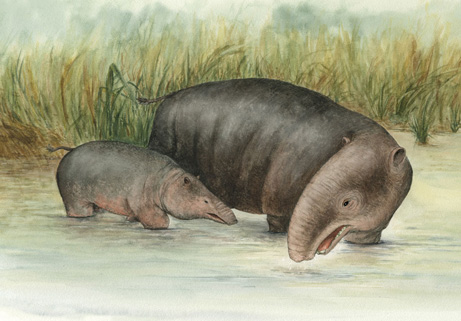Ancient elephant ancestors lived under water
A study shows that the genealogy of the largest animal that still exists on the ground may have roots from the water.
Chemical signs from fossil teeth reveal that at least one species belongs to proboscidean, ancient elephant relatives, living in water environments.
According to Alexander Liu, Oxford University's Department of Earth Sciences, the teeth of an ancient animal, of the genus Moeritherium, show it eats freshwater plants and settles in marshes or river systems . Also according to Liu, the lead author of a recent study conducted on animal teeth, 'It is particularly a living creature similar to hippopotamus. That's the closest animal we can think of today. '
Today's elephants and their extinct relatives are associated with ancestors of manatees, dugongs and other aquatic mammals belonging to the manatee.
Moeritherium breeds lived about 37 million years ago, many millions of years after the gene division between elephant and manatee.

Artwork drawn by a painter with a Moeritherium matured with its child.A new study of this species' teeth shows that it is an amphibian, eating fresh water plants and settling in marshes or river systems.(Photo: Luci Betti-Nash, Stony Brook / PNAS University)
Mysterious decoding teeth
Moeritherium is not much like the current elephant. It is as high as a tapir (74 to 107cm). The animal seems to lack a tap, but the lower lip may be longer than normal.
His teeth were excavated in the Faiyum region of northern Egypt, a shallow estuary or near the coast in ancient times and subject to frequent changes in the environment. The Moertherium fossil found in the rock contains solid evidence that this place was once a swamp or a river system. But scientists have a hard time deciding whether this animal lives in the environment or their bodies are washed away after death.
Finally, the teeth themselves will give the answer.
The carbon isotope in enamel contains evidence of Moeritherium's diet, while oxygen isotopes reveal information about water sources.
By comparing the proportional variation of these isotopes with those of terrestrial animals living at the same time, the scientific group agreed on proboscidean species as amphibians.
Their work appears in the Proceedings of the National Academy of Sciences.
From the mainland to the sea and back?

Moeritherium (Photo: Discovery)
William Sanders, of the Museum of Paleontology, University of Michigan, argued that this was an ' excellent ' project when it came to convincing evidence that Moeritherium was an amphibian.
'Paleontologists learn every question for nearly a century that moerithere is at least an amphibian, like a manatee or hippopotamus during adaptation and in their lifestyles.' However Sanders is cautious before the hypothesis that modern elephant ancestors are underwater animals or even all primitive proboscidean living underwater.
'Moeritherium is a very specialized animal and may have detached from the main evolutionary strain that leads to elephants today.' This creature also lived long before the modern elephant appeared about 7 million years ago. So Sanders noted that if elephants actually have ancestors living in the water, evolution to land for 20 million years may also leave no trace to this day.
' A common story about elephants is their hose evolved to make breathing tubes in water environments. In fact, primitive proboscidean lacks the protruding nose, the development of the tap is due to the expansion of the tusks and the adaptation of feeding on the mainland. '
Liu hopes to resolve these questions by examining even older elephants' teeth to discover more about when they changed their lifestyles and when the manatee separated from their relatives. them.
He is also concerned about the possibility that proboscidean species will provide the first evidence of terrestrial animals moving to underwater and then returning to the mainland.
He explained: 'The first mammals are terrestrial species. For the mammalian group that once lived on land and then moved into the water, it seemed Moeritherium had been like that, then returned to the mainland - as our data suggests - to be a very reasonable possibility. interesting. '
- Found the ancient elephant remains that lived 3 million years ago
- The ancestors of humans once lived on a mountain of 4,000m high through the Ice Age
- Discovered ancient elephant footprints
- Video: Humorous scenes of mother elephants rescuing children from drowning
- Why do the ancient ancestors of human beings walk on two legs?
- The ancestors of flowers are bisexual plants
- Species ancestors who once eat cannibalism
- Indonesia's ancient dwarf was wiped out by human ancestors?
- Today's whales migrate with the same path their ancestors lived 270,000 years ago!
- The truth is that the ancestors of ancient elephants and rhinos appear to be more 'monstrous' than they are today!
- Fossils reveal the ancestors of today's lizards and snakes
- Wild buffalo buffalo elephants fly a few meters
 Discovered an ancient centipede fossil 99 million years old
Discovered an ancient centipede fossil 99 million years old Discovered bat-like dinosaurs in China
Discovered bat-like dinosaurs in China Discovered a 200-year-old bronze cannon of the coast
Discovered a 200-year-old bronze cannon of the coast Discover 305 million-year-old spider fossils
Discover 305 million-year-old spider fossils